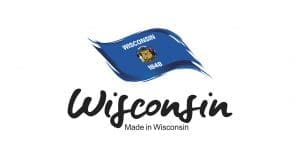Consumers continue to embrace the unique opportunity for first-time homebuyers in Wisconsin. People in the community are taking advantage of the Wisconsin’s supportive home buyer programs and relatively moderate housing trends. Home prices in Wisconsin have risen 4–5% year-over-year, with the median price hovering around $346,700. While this upward trend may seem daunting, it’s still below national averages, making Wisconsin more accessible than many other states.
The Wisconsin Housing and Economic Development Authority (WHEDA) provides targeted assistance for first-time buyers, including low-interest loans and down payment support. Programs like WHEDA Advantage and Easy Close DPA offer flexible financing options, some with zero down payment and deferred repayment. These can significantly reduce upfront costs, which is often the biggest hurdle for new buyers. The RefiGuide will help you navigate the mortgage process and connect you with the best Wisconsin lenders for first time home buyers.
How Wisconsin First Time Buyers Are Getting Approved for Home Loans

Buying your first home in Wisconsin can be an exciting yet daunting journey.
With rising home prices, fluctuating interest rates, and the need for substantial down payments, many aspiring homeowners feel overwhelmed.
However, Wisconsin offers a robust array of programs designed specifically to support first-time buyers. In 2025, the state’s housing market continues to show resilience, with median home prices around $300,000, according to recent market analyses.
This guide provides a comprehensive overview of eligibility requirements, state and local assistance programs, mortgage options, and practical tips to help you navigate the process. We’ll also highlight top local lenders specializing in first-time buyer financing and share two real-world case studies to illustrate how these resources can make homeownership achievable.
Who Qualifies as a First-Time Home Buyer in Wisconsin?
In Wisconsin, a first-time home buyer is typically defined as someone who hasn’t owned a primary residence in the last three years. This definition aligns with most federal and state programs, allowing even previous homeowners to qualify if they meet this criterion. Key eligibility factors include:
- Income Limits: Many programs cap household income at 80-140% of the area median income (AMI), depending on the county. For example, in Milwaukee County, the AMI for a family of four is approximately $100,000 in 2025.
- Credit Score: A minimum score of 620-640 is often required, though some programs offer flexibility.
- Home Price Limits: Purchases are capped based on location, typically ranging from $300,000 to $450,000.
- Homebuyer Education: Most programs mandate completing a certified course, which covers budgeting, credit management, and the home-buying process.
These requirements ensure assistance reaches those who need it most, promoting sustainable homeownership.
State Down-Payment Assistance Programs in Wisconsin
Wisconsin’s primary state agency for housing support is the Wisconsin Housing and Economic Development Authority (WHEDA). WHEDA offers several programs tailored for first-time buyers, including low-interest mortgages paired with down-payment assistance (DPA). Here’s a breakdown of key state-wide programs, with direct reference URLs:
- WHEDA Advantage Conventional Loan: This 30-year fixed-rate mortgage requires as little as 3% down and can be combined with DPA. It’s ideal for buyers with good credit.
- WHEDA Advantage FHA Loan: Backed by the Federal Housing Administration, this allows down payments as low as 3.5% and is forgiving on credit history.
- Easy Close DPA: A second mortgage providing up to 6% of the home’s purchase price (minimum $1,000) for down payment and closing costs. It features 0% interest and deferred payments until the home is sold or refinanced.
- Capital Access DPA: Offers a fixed $7,500 second mortgage at 0% interest, repayable upon sale or refinance. It’s stackable with other WHEDA loans.
Additionally, the Federal Home Loan Bank of Chicago’s Downpayment Plus (DPP) program provides grants up to $10,000 for income-eligible buyers (up to 80% AMI). This is a forgivable grant after five years of occupancy.
The HOME Homebuyer and Rehabilitation Program (HHR), administered by the Division of Energy, Housing and Community Resources, offers direct assistance for acquisition, down payments, closing costs, and rehabilitation. Funds are distributed through local governments and nonprofits.
These programs have helped thousands achieve homeownership, with WHEDA alone assisting over 141,800 buyers historically .
Local First-Time Home Buyer Incentives in Wisconsin
Beyond state programs, many Wisconsin cities and counties offer localized incentives, often in the form of forgivable grants or low-interest loans. These are typically funded through federal HOME funds or community development blocks. Here are prominent examples with reference URLs:
- Milwaukee Home Down Payment Assistance Program: Forgivable grants up to $7,000 ($5,000 standard) for first-time buyers in targeted areas. Must complete homebuyer education.
- Madison Home-Buy the American Dream (HBAD): Provides up to $35,000 in forgivable loans for down payments and closing costs, aimed at low-to-moderate income buyers.
- Janesville Home Possible Program: Loans up to $10,000 for down payments and closing costs, forgivable after 10 years. Targets households at or below 80% AMI.
- Wausau Down Payment Assistance: Offers up to $5,000 in forgivable grants for eligible first-time buyers.
- Fitchburg Down Payment Assistance Programs: Grants and low-interest loans up to $10,000, partnered with local credit unions.
Other areas like Green Bay and Eau Claire may have similar programs through Habitat for Humanity or local housing authorities. Always check with your county’s community development office for updates, as 45 new programs were added nationwide in Q2 2025, including some in Wisconsin .
Mortgage Options for First-Time Buyers
First-time buyers can access conventional, FHA, VA, or USDA loans. WHEDA partners with lenders to offer reduced rates. Credit unions like UW and Summit provide specialized products with low fees. Expect interest rates around 6-7% in 2025, but DPA can lower effective costs.
Top 10 Local Mortgage Brokers and Lenders in Wisconsin Specializing in First-Time Buyers
Based on reputation, volume, and focus on first-time programs, here are the top 10 Wisconsin-based lenders (all located in WI):
- Summit Credit Union (Madison): #1 in WI for mortgages, offers low-down-payment options and education.
- UW Credit Union (Madison): Specializes in first-time buyer mortgages with DPA integration.
- Associated Bank (Green Bay): $500 closing cost credit for first-timers.
- Park Bank (Madison): Tailored guidance for new buyers.
- North Shore Bank (Milwaukee): Flexible first-time loans with quick approvals.
- Royal Bank (Elroy): Southwest WI focus, pre-qualification for beginners.
- Heartland Credit Union (Madison): Best for low-credit buyers.
- Johnson Financial Group (Racine): Affordable loans with minimal down payments.
- Waterstone Mortgage (Appleton): Competitive rates and WHEDA partnerships.
- MidWestOne Bank (Onalaska): First-time programs with fast closings.
These Wisconsin mortgage lenders are headquartered in WI and emphasize first-time financing.
Case Study 1: Ben and Carrie’s Journey in Greenfield
Ben and Carrie, a young couple in their late 20s, dreamed of owning a home but struggled with saving for a down payment while paying rent in Milwaukee. Earning a combined $75,000 annually, they qualified as first-time buyers. They utilized WHEDA’s Easy Close DPA for $12,000 toward their $200,000 home purchase, combined with a Summit Credit Union mortgage. After completing a homebuyer education course, they closed in May 2025. The forgivable loan aspect meant no extra payments, and they saved thousands in closing costs. Today, they’re building equity in Greenfield, crediting local incentives for making it possible .
Case Study 2: Jaki’s Habitat Home in Green Bay
Jaki, a single mother earning $45,000, faced barriers due to limited credit history. Through Greater Green Bay Habitat for Humanity, she accessed a 0% interest mortgage and down payment assistance via the Downpayment Plus grant ($6,000). The program required “sweat equity” hours building her home, which was dedicated in 2022 but updated with 2025 funds. Paired with a North Shore Bank loan, she purchased a $150,000 property. Now, her family enjoys stability, and Jaki reports improved financial confidence .
Tips for WI First Time Home Buyer Success in 2025
- Get Pre-Approved: Start with a lender to know your budget.
- Budget for Extras: Factor in property taxes (average 1.6% in WI) and insurance.
- Monitor Market Trends: With inventory low, act quickly but inspect thoroughly.
- Seek Counseling: Free sessions from HUD-approved agencies can boost your readiness.
In conclusion, Wisconsin’s supportive ecosystem makes 2025 an opportune time for first-time buyers. By leveraging state DPA like WHEDA’s offerings, local grants, and specialized lenders, you can turn homeownership from a dream into reality. Consult professionals and start your journey today—your new home awaits.
FAQs for Wisconsin First Time Home Buyers:
What are the qualifications for first-time homebuyer grants in Wisconsin?
Wisconsin first-time buyers can utilize WHEDA programs or local grants like Downpayment Plus, which provides up to $6,000 in assistance for qualifying buyers meeting income limits and HUD guidelines. You must be a HUD-defined first‑time buyer (no ownership in past three years), use the home as your primary residence, complete a homebuyer education course, and work with a participating lender. Some programs require local residence or property in certain counties or cities.
What are the credit score requirements for down payment assistance in Wisconsin?
To qualify for WHEDA and other assistance, you generally need a minimum credit score of 620 for conventional loans and 640 for FHA-based programs. FHA loans elsewhere allow scores down to 580, though Wisconsin lenders often require 640. Better terms may come with scores of 680 or higher. Credit requirements can also be influenced by debt-to-income ratios, reserves and program-specific underwriting rules.
When can first-time buyers get a home equity loan in Wisconsin?
In Wisconsin, first‑time homebuyers must close on a WHEDA‑backed (or equivalent) mortgage and establish equity before getting a HELOC or equity loan. Because most programs require owner-occupancy and equity accumulation, lenders typically require a six‑month to one‑year wait before approving a HELOC in Wisconsin.
What is Wisconsin’s unemployment rate?
Wisconsin maintained a low unemployment rate averaging around 3.0% in 2024, significantly below the national average of about 4.0%. Through early 2025, joblessness remains near that historically low rate. Economic growth has been steady but modest, and forecasts expect Wisconsin’s unemployment rate to stay under 3.5% by 2027, outperforming many other states Wisconsin Department of Revenue.
What is the average age of a first-time homebuyer in Wisconsin?
While state-specific data isn’t published, the national median age of first-time buyers is 38, a record high reached in 2024. Given that Wisconsin largely mirrors national homebuying trends, the average age for first-time buyers in the state is likely around 38 years old. Younger and lower-income households face affordability challenges, delaying entry into homeownership across the board.
How many people rent vs. buy homes in Wisconsin?
Wisconsin’s historical homeownership rate has averaged around 65%, with peaks near 73% in the early 2000s. Most recently, homeownership is estimated at roughly 65%, meaning about 35% of occupied housing units are rentals. That aligns with U.S. figures but is somewhat higher than homeownership in more expensive coastal states. Owner-occupancy remains strong in suburban and rural Wisconsin markets
